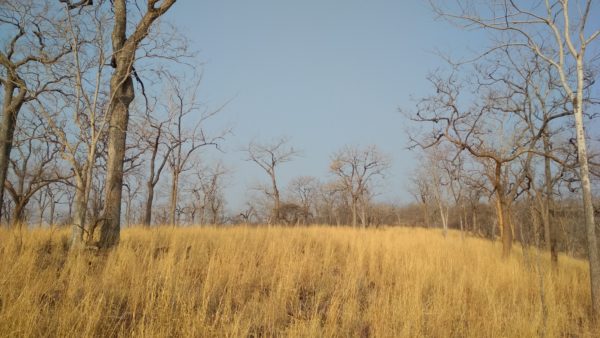
Grasslands of Amrabad Tiger Reserve © Kiran Yadav
The Serengeti is a vast and varied landscape, with savannah, hilly woodland and grasslands thrown in. The Amrabad Tiger Reserve in Telengana is one of the biggest parks in India. Here too, you will find a mix of dry, deciduous scrub, woodland and grassland, with what some ecologists believe are a savannah spread. If the Serengeti has granite outcroppings in its grasslands, the Indian tiger reserve also has its share of quartzite rocks overlaid with slate-like formations. The Serengeti has its Mara, the ATR has the mighty Krishna flowing at its southern edge. Both places see a typically warm and dry climate. However, that is as far as the major similarities go.
At ATR, you will not come across stamping herds of wildebeest or lion prides or zebras. Or the many other diverse wildlife found there. But according to authorities, the region has its own wide range of fauna which includes rhesus macaque, tiger, leopard, langur, wild dog, jungle cat, sloth bear, Indian giant squirrel, smooth-coated otter, striped hyena, wild boar, palm civet, Indian muntjac, sambar, spotted deer, four-horned antelope, nilgai, Indian pangolin, Indian porcupine, chinkara and so on.
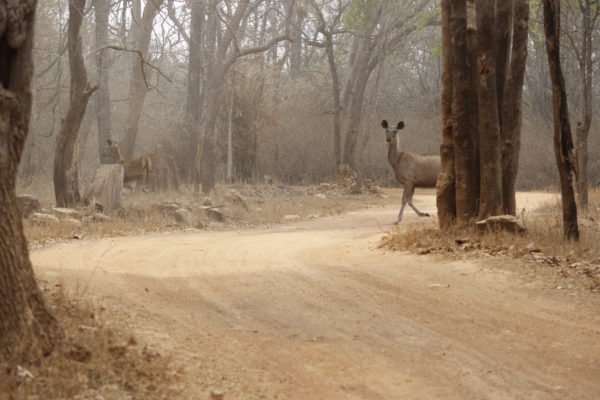
Sambar, tiger, leopard, langur, wild dog, jungle cat, sloth bear, giant flying squirrel, striped hyena are some of the fauna found here. © Kiran Yadav
Beyond the fauna which differs, Serengeti national park has no human inhabitants, as they were all forcibly removed. At ATR, there are around 3-4000 people living inside, including the Chenchu tribals and others.
The biggest difference between the two protected areas – in Africa and India – is that where Serengeti is pretty well-known globally, and not just among wildlifers, ATR is not even known within the country. A part of this poor marketing could be traced to the posse of wildlife photographers, seen in other protected areas, but missing here as “dry, degraded land is not very sexy” to quote a local environmentalist.
Perhaps, a cursory visit through the reserve in the hot months of summer may not attract the average shutterbug. What greets the eye is stretches of plain woodlands that are markedly brown and black – thanks to the trees that have shed leaves and stand bare, and the ground that is mostly ash-filled from grass that has been set on fire! In most places, the ground is littered with small boulders that make walking a daunting task, more so for the intrepid cameraman with his eye all over the place except the ground. The soaring temperatures do not encourage anyone except ones who are fit and ready to weather it out.
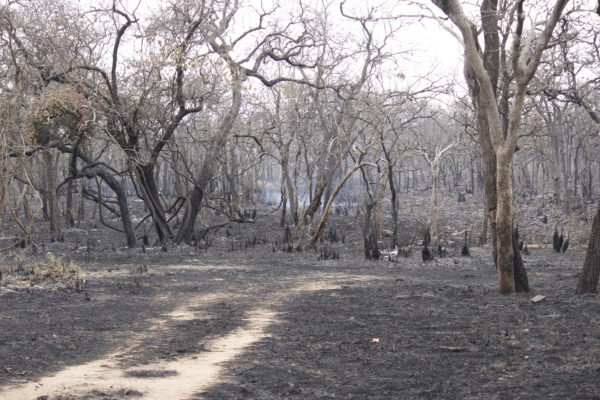
The charred and rock-strewn grounds © Kiran Yadav
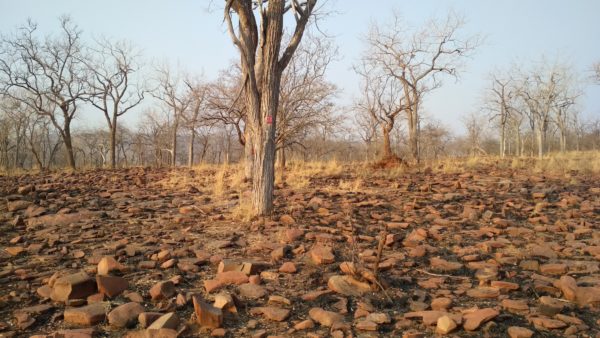
But, for the patient person, the place has its many treats that go beyond the dazzling sight of a peacock against the monochrome brown background. A nilgai stops to check you out, giant squirrels leap between tree branches, a hare freezes in motion with ears all perked up, chital seem to find something to nibble on amidst the dry foliage, the endemic and rare yellow throated bulbul throws up a pleasant surprise, dhole packs go chasing a chital … And if your luck holds on, a leopard may cross the road or a tiger roar somewhere nearby, or even more heart-stopping, a momma sloth bear with cubs riding piggy-back could appear just where the grassland dips in a gentle curve, enough to allow you to make a slow retreat and remain undetected by the much-maligned, but unpredictable mammal.
Be prepared though that such sightings could be few and far in between during hot, blistery days. Some days can rise and fall without a single animal sighted. And still, there is a lot to be awestruck and mesmerised by, besides the humbling fact that life thrives even amidst such harsh conditions.
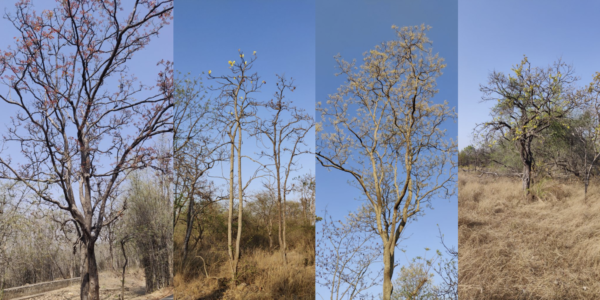
For the botanist, there is a feast of species with each kind having its unique method of surviving the heat and drought. Nature caters to its kind, with juicy offerings like the mahua flower which can be seen strewn on the forest floor. The scarcity of water, except during rains, means that many of the trees found here are the hardy kinds and few grow very tall. Most prevalent are varieties of terminalia, hardwickia, cassia and pterocarpus. Even while a large number of trees belong to the dry, deciduous family, the terrain throws up occasional bursts of green from some evergreen species. And once the rains come, the place transforms. All it needs is a drizzle for the vegetation to turn green from brown!
Punctuating the terrain every few hundred metres or so are giant termite mounds. Since termites feed on a diet of wood, soil, leaf litter, their abundance signifies availability of these food sources. By their presence, the mounds contribute to the ecosystem productivity and point to rich mineral deposits as well as good ground water.
But let’s begin with the history of this beautiful, yet ignored landscape.
One of the least explored landscapes of India, the Eastern Ghats is believed to be older than the Western Ghats (Wiki) with the local geology traced to the break up of the ancient supercontinent of Rodinia and the subsequent formation of Gondwana. Stretching for 1,750 km from central Odisha, through Andhra Pradesh and Telangana, the ghats end in southern Tamil Nadu.
As part of the (LEMON) Long-term Ecosystem Monitoring Network, a network of 1 ha forest monitoring plots along various environmental climes and across habitat types have been set up since 2011 by the BEER Laboratory at NCBS, Bangalore to understand the carbon dynamics involved. How structure and function of plant communities change with environment, how the plants respond to the factors are hoped to be understood in order develop a long-term sustainable forest management plan. A LEMON plot at ATR has scientists measuring the growth of the trees, the leaf and seeds shed in a unit area, etc as part of the study.
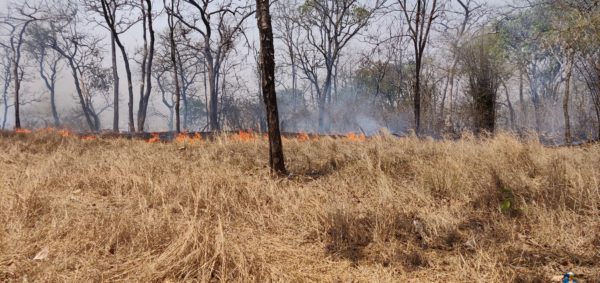
Setting the grass on fire is a common practice © Kiran Yadav
Unfortunately, even before an understanding of the flora and fauna can develop, recent news said that the Ghats has lost 16% of its forest cover in a 100 years. The study by University of Hyderabad compared historical maps with satellite images to conclude that the forest cover has gone from 43.4% in 1920 to 27.5% in 2015. A major part of this was converted into agricultural fields, while another bit was converted into scrub or grassland. The study found fragmentation of habitat had gone up almost ten times! Over 2500 plant species are endemic to the region.
According to Imran Siddiqui, Assistant Director, WCS-India and co-founder of HyTiCos, it was following the discovery of tigers in 2012 in camera traps that the region caught some attention. Since then, there has been increased funding and a sense of pride around protecting the place, he says. Over 300 Chenchus employed in the protection of the forest. “Today, tigers have been spotted right up to south of GBM!” This covers in essence a contiguous stretch of 7000 sq kms of contiguous forests in Nallamalla hills of the Eastern Ghats, he adds. He is however clear that with the big picture in mind, conservation works only with the involvement of the community. He also believes that relocation must be voluntary.
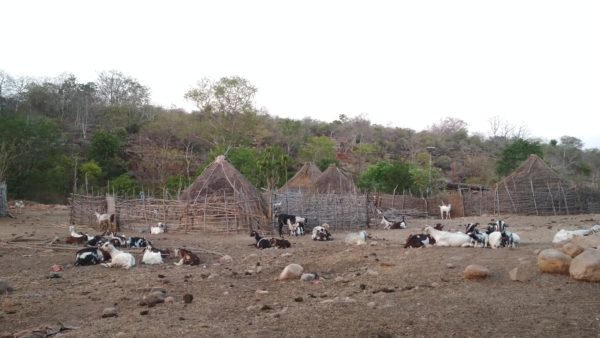
Goats reared by the Chenchus © Kiran Yadav
The entire north-eastern part of the reserve is largely degraded forests, with plenty of encroachments making the area porous. Timber is extracted for housing, furniture and fencing the agricultural lands against the large cattle numbers. The local Thurupu cattle, that appear like they have been spray painted, begin to go further into the core once the heat turns on and food gets scarce. Many households rear goats too. The tribes themselves go into the forest looking for tubers, gums, berries and honey. Not to forget the mahua! A delicacy vied by both man and animal for its taste and heady effect!
Some of the settlements inside the forest have large cattle holdings. It is as part of catering to their fodder needs that the grasslands are often set fire to. The clearing also facilitates the collection of berries, etc that are harvested by the locals. Poaching of prey species for meat is also rampant as is evident from the snares recovered during a recent survey.
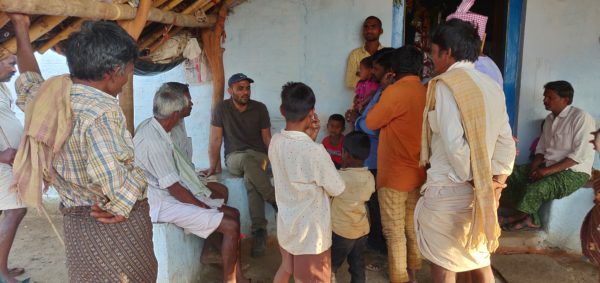
At Mallela village, the residents requesting Imran Siddiqui to look into their relocation applications
There are around 1000 families of Chenchu tribals living across the ATR landscape. About 600 families had shown interest to move out a few years ago, but nothing much has been done. During a recent visit to the Mallela village, the frustration of the people was evident as they gathered around Imran, pleading with him to take up their case with the department. There are also the other lot who do not want to move out, content to stay inside the reserve, raising cattle and growing crops like groundnut, cotton, etc. In settlements like Appapur, most of the youth are educated and some employed by the forest department.
Another issue raising its troublesome head in this wilderness is the temple tourism that draws in increasing numbers of pilgrims every year. At the Bairapur temple, the recently started (since 2017) annual jatra during April draws more than 15,000 people in three days while the Saleshwaram temple further inside the forest attracts over two lakhs pilgrims in four days. The whole area ends up strewn with plastic waste. Some regulation of crowds and imposition of rules could help mitigate the situation, feel activists.
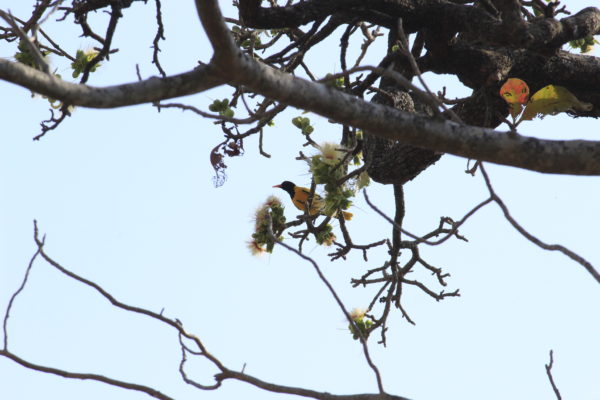
Black-headed oriole © Kiran Yadav
Caught between competing populations, and disastrous practices, one is left wondering if this ancient wilderness will stay intact a few decades down the line. What the book Serengeti Shall Not Die did in raising global awareness on the need to save the place in the face of hunting, habitat loss, conflicts rising from exploding human population and poverty, will perhaps need to be repeated here too.
There are the small and dedicated numbers of scientists and conservationists who are raising the slogan. “The Eastern Ghats are no less magical or beautiful than the Western Ghats and need to be conserved,” emphasise ecologists like Sachin Sridhara, working in the region. To conservationists like Imran, who work with the department and the people, spending long hours for days together in the field, “there is hope still as long as there are such amazing places and animals there worth fighting for.”
Hopefully Amrabad will not die.
Written by Jayalakshmi K